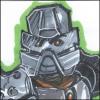
My grandmother
By Sumiki,
Words can’t even begin to describe the misery she went through in the past several years of her life. Her immense medical record was just about as long as the list of doctors who were mortified at the prospect of having to navigate the murky medical waters of a woman who, by all rights, should have been dead five times over. Between her assisted living facility, the various wards of the hospital, and rehab facilities spanning across several counties, she was a threat to sap the combined medical resources of the greater Charlotte area. 77 is not an old age, but aside from her thinning, yet stubbornly black hair, her body might as well have been 97.
I don’t know, at this point, what finally did her in, but I can venture a guess that it’s something to do with the all-too-uncommon perils of someone with her comorbidities: her stage 2 kidney failure prevented her from taking the full dose of diuretics necessary to get the inevitable fluid buildup away from her heart and lungs, while her stage 3/borderline stage 4 heart failure had a hard time keeping up with the volume overload. People in her condition walk a thinner and thinner tightrope until they (or their loved ones) are forced into choosing death by kidney failure or death by heart failure.
It was getting to a point where we would have been forced into making a difficult decision on her behalf. While she never suffered from any sort of neurological conditions (other than lifelong anxiety and depression), she was so tired—especially in the final months—that she could barely lift up her head, and her generally high creatinine levels (a byproduct of kidney failure) led to many a moment when the vivid imagination of her dreams got to her in her few remaining waking hours. She would have been in no condition to weigh the awful choice which was coming her way; a nursing home would have been the next step, and that process would have been an unimaginable emotional anguish for everyone involved.
Her passing, while undeniably sad, is a weight lifted. Her condition would have killed a lesser person, and her life is a testament to a strength of willpower so strong that the rest of us would do well for ourselves in life if we had the tiniest fraction of hers.
You often hear about deaths like this being sad, but not too sad, because they’re “expected.” As cliché as that might be, I can attest to its accuracy, having seen her on her deathbed on multiple occasions within the past several years. It was hard on those occasions because we grieved her passing and got through the emotions associated with such a loss, only for her to pull out and get through another two years.
Even towards the end, she had good days, good weeks, and even good months. She found as much joy as possible in the little pleasures and comforts still available to her—watching the livestream of my graduation, hosting her bridge club for the final time—up through May. When it became clear that her body wouldn’t get back to the quality of life she once enjoyed, it shut down for good; that fight to get to the next goal, the next thing-she-was-looking-forward-to, just wasn’t there this time.
If there’s anyone who taught me perseverance in the face of adversity, it’s her, and I hope that I can follow her example for the rest of my life.
- Read more...
- 1 comment
- 943 views

